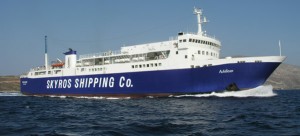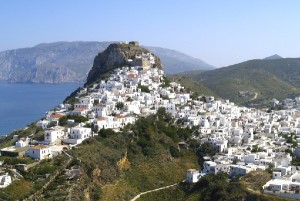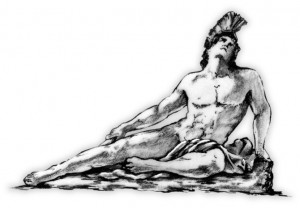Few Words about Skyros island
Skyros, an island in the heart of the Agean sea doesn’ t belong only administrately to Evia but it is also maintains a relationship which could be characterized as a mother – daughter relationship because both Evia and Skyros have similar geographical features. Also, the island of Evripus offers the shortest sea route to Skyros from Kimi, which is only 22 nautical miles away.
The Agean island of Skyros is the largest and southernmost island of the group of islands “Sporades” and is situated south – east of Kimi. Its unique position in the pelagos makes it resemble a stone boat, which which froze in time as it was sailing over the waves of the sea. Strong winds sweep across the island bringing refreshing breezes and the resounding sounds of the sea.
Some geologists claim that Skyros was made up of three islands that were joined together. There is some evidence that this may be true as there are many differences in the geographical features in various parts of the island. In the north it is thickly forested, in the south bare and rocky and in the center of Skyros there is a channel 3 kilometers wide. The island is 210 square kilometers and is surrounded by a large number of small islands and rocky islets.
The capital of the island is Skyros, which is also called Chora by the locals. It is situated to the north – east of the eastern side of the foot of the mountain Olympus. It is 10 kilometers from Linaria, the main port of the island situated in the center of the western coast. The town of Skyros is built amphitheatrically on the sloaps of a hill under the shadow of a medieval castle and the Byzantine monastery of Saint George of Skyros. It is a typical island city with Agean – style architecture with its own particular color. The beauty of the town with its white, cube – shaped houses and dark – colored roofs makes a great impression on the visitor. The main avenue crosses the town and leads to the square of “Eternal poetry” which is named, not only because of the existence of the statue dedicated to the English poet Rupert Brooke, but also because of the poetical disposition which is evoked in the visitor from the unique view of the island and Agean pelagos. From this main avenue there are many small winding roads, which lead in all directions from the town.
Many seaside resorts frame the city of Skyros. The community of “Magazia”, which has one of the finest beaches, is nearby. There are also the beaches the beaches of Molos and Para Kambos. The tourist resort of Aspous lies between the town and Linaria. Linaria, apart from being the port of the island is a picturesque, amphitheatrically community which is very popular with the tourists. Near Linaria there are the beaches of Kalamitsa, Acherounes and Pefkos. Particularly interesting is the northern part of the island where the landscape of the Skyrian Olympus and the pine-forested beaches remind one of northern Evia. It’s worth visiting the north – west coast, Ayio Petro and Kira Panagia as well as Atsitsa. It would be even more adventurous to tour the southern part of the island where its highest mountain Kochila is really impressive. In this area, it is dry and rocky and resembles southern Evia. It is also worth going to Tris Boukes, a large natural harbour the entrance of which is fenced by the small islands of Plati and Sarakino. At Tris Boukes one can find the grave of the English poet Rupert Brooke who died here on this way from Kalipoli. On touring the island the visitor will come across the Skyrian rare breed of ponies.
The history of Skyros
Skyros has been inhabited from the Stone Age as evidenced from the findings from the area of Castro. The first inhabitants of the island were “Kares”, “Pelazyi” and “Dolopes”. This is why it was first called Pelazyia or Dolopia but also the island of magnets.
According to Greek mythology, Thetis the goddess mother of Achilles, had sent her son to Skyros to avoid taking part in the Trojan campaign so that the prophesy that he would be killed would not come true.
At Skyros, Achilles was brought up by king Likomidi among his daughters and he himself was dressed like a girl. He fall in love with one of the king’s daughters, Diidamia and they had a son called Neoptolemo. When Kalchas prophesied that Troy wouldn’t be captured without the participation of Achilles, the ingenious Ulysses came to Skyros and using a cunning trick discovered where Achilles was. Afterwards, Achilles became the leader of Mirmithones and he led them to Troy.
After the death of Achilles in Troy, Ulysses returned to Skyros, this time seeking Neoptolemo. According to a prophesy of Elenou Troy would not fall unless the son of Achilles fought under its walls. In spite of king Likomidi’s reluctance to let him go, Neoptolemo was determined to fight because, like his father, he craved for war and glory.
At Skyros, according to mythology the king of Athens, king Likomidi threw Thiseas, from the cliffs into the sea because he was feared for his throne. During the time of the first Athenian Alliance general Kimon campaigned to expel the Dolopes from the island. The latter were pirates and were a threat to the commercial fleet in the north – east Agean. Kimon wanted to occupy Skyros on behalf of the Athenian Alliance, expelled the Dolopes and distributed the land among the Athenians. As this was the beginning of the Alliance, it was political expedience for the Athenian aristocrats to be given divine sanction for their activities. This is why, obeying the old oracle of the Delphi, Kimon transferred the bones of the hero Thisea with great pomp and ceremony, to Athens where they were placed at Thiseon.
During the Macedonian rule, Skyros belonged to the Athenian allotment holders. It came under the rule of the Macedonians and then the Romans who donated back to the Athenians. During the early Byzantine period the island didn’t flourish but in the middle Byzantine period it benefited from its econimic prosperity and became a Bishopric.
After the capture of Constantinople by the Crusadors (1204) Skyros was ruled by the Venetians. At the end of the 14th century it was occupied by the Turks but a little later through a treaty it was handed over the Byzantium again. After the capture of Constantinople by the Turks in 1453, it surrendered to the Venetians and became a colony of the state of Venice.
During the first Turkish – Venetian war Skyros was set fire to by the Turkish fleet that were not able to capture the castle, but after the raid by the notorious pirate Hairentin Barbarosa, Skyros submitted to the Turks. During the 2nd Turkish – Venetian war the Venetians ruled again for some years, but the island was soon under Turkish rule again.
During the Greek revolution of the 1821 the participation of the inhabitants of Skyros was significant in both land and sea operations and the island became a refuge for refugees. Skyros was liberated, together with the rest of the Sporades, in 1829.
Today, Skyros, by maintaining its local architectural style, its local color and folklore traditions is a living museum of the old life style of the island. The cube – shaped houses are distinguished not only for their beauty but also for their economy of space. Its popular art lives creatively in the field of handicraft, ceramics and embroidery.
The natural and social environment inspires the ornamental motives. Many customs record the popular conscience of the inhabitants. The Skyrian carnival festivity is one of the most important events. This is a tradition, which goes back to the worship of Dionyssius, but also to the eternal desire of man to provoke the creative powers of nature.
Transport
- You can come to Skyros island by coastal navigation via Kymi.
- To Kymi you can arrive by car via Xalkida (178klm.) or via Oropos – Eretria (you have to take a boat) (128klm.).
- When you arrive to Kymi (pay attention to the signs – “TO PORT”) you will embark to the ferry “ACHILLEAS”…
…and in two hours you’ll be arriving at the Port of Skyros “Linaria”.
The ship’s schedule according to Skyros Shipping Company
INFORMATION & RESERVATIONS
ACHILLEAS
KYMI AGENT Tel.: 0030 22220 22020 & 0030 22220 22522
SKYROS AGENT Tel.: 0030 22220 91790
LINARIA AGENT Tel.: 0030 22220 96465
ATHENS AGENT “ALKYON” Tel.: 0030 210 3843220 & 0030 210 3843221

- Skyros island also connects with Athens 3 times a week by plane, on Wednesday,Saturday and Sunday and also with Thessaloniki 3 times a week, on Monday, Tuesday and Saturday.
- Kymi also connects with Xalkida – Athens by KTEL bus. Bus Station: 260 Liosion Str., Athens. Τel.: 0030 210 8317153 – 0030 210 8317163.



